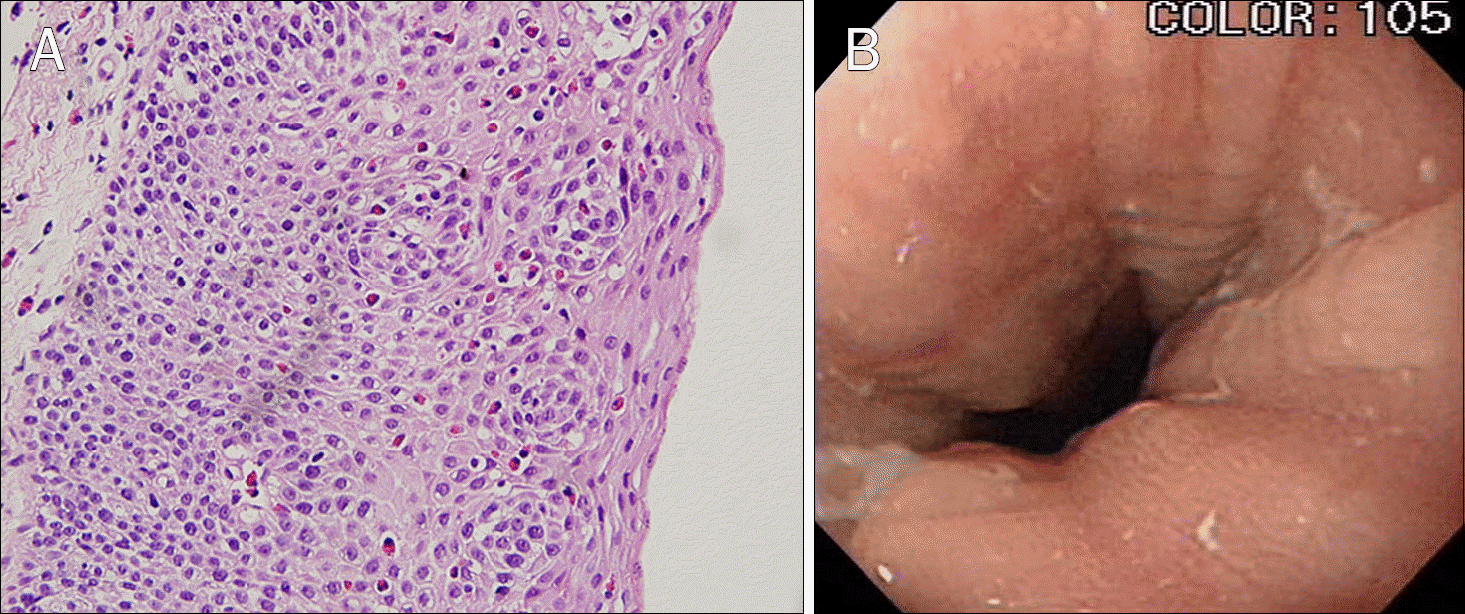Abstract
Background/Aims
Eosinophilic esophagitis (EoE) is a chronic, immune/antigen-mediated esophageal disease, with eosinophilic infiltration limited to the esophagus. A minority of EoE patients respond well to proton pump inhibitor (PPI) therapy alone, and that condition is labelled PPI-responsive esophageal eosinophilia (PPI-REE). The prevalence of PPI-REE among EoE cases is unknown. We aimed to identify clinical manifestations of PPI-REE, and the proportion of PPI-REE among all EoE cases.
Methods
We reviewed pathology of the 4,075 patients who underwent esophageal biopsy at an institution from March 2003 to July 2015. EoE was diagnosed based on esophageal symptoms and eosinophilic infiltration limited to the esophagus, with ≥15 eosinophils per high-power field. We collected endoscopic and pathologic findings, and clinical features for these patients.
Results
Thirteen (0.3%) patients were diagnosed with EoE. Clinical manifestations were dysphagia (30.8%), foreign body sensation (23.1%), regurgitation (23.1%), cough (15.4%), heartburn (15.4%), nausea (7.7%), dyspepsia (7.7%). The endoscopic findings noted were polypoid lesion (23.1%), whitish plaque or exudate (23.1%), linear furrow (7.7%), concentric ring (7.7%), nodularity (7.7%), erosion (7.7%), and normal (30.8%). Of these patients, five had a favorable course with PPI as monotherapy.
Conclusions
The proportion of EoE among all patients undergoing endoscopic biopsy was 0.3%. Of those, PPI-REE comprised 38%. Most of the endoscopic findings were atypical or normal when compared to the typical findings in EoE. In conclusion, patients who present with symptoms related to esophageal dysfunction need esophageal biopsy, regardless of the endoscopic findings. Moreover, patients diagnosed with EoE need to be treated first with PPI alone.
Go to : 
References
1. Brown LF, Goldman H, Antonioli DA. Intraepithelial eosinophils in endoscopic biopsies of adults with reflux esophagitis. Am J Surg Pathol. 1984; 8:899–905.

2. Winter HS, Madara JL, Stafford RJ, Grand RJ, Quinlan JE, Goldman H. Intraepithelial eosinophils: a new diagnostic criterion for reflux esophagitis. Gastroenterology. 1982; 83:818–823.

3. Attwood SE, Smyrk TC, Demeester TR, Jones JB. Esophageal eosinophilia with dysphagia. A distinct clinicopathologic syndrome. Dig Dis Sci. 1993; 38:109–116.
4. Richter JE. Current management of eosinophilic esophagitis 2015. J Clin Gastroenterol. 2016; 50:99–110.

6. Landres RT, Kuster GG, Strum WB. Eosinophilic esophagitis in a patient with vigorous achalasia. Gastroenterology. 1978; 74:1298–1301.

7. Prasad GA, Alexander JA, Schleck CD, et al. Epidemiology of eosinophilic esophagitis over three decades in Olmsted County, Minnesota. Clin Gastroenterol Hepatol. 2009; 7:1055–1061.

8. Dellon ES, Jensen ET, Martin CF, Shaheen NJ, Kappelman MD. Prevalence of eosinophilic esophagitis in the United States. Clin Gastroenterol Hepatol. 2014; 12:589–596.e1.

9. Ngo P, Furuta GT, Antonioli DA, Fox VL. Eosinophils in the esophagus–peptic or allergic eosinophilic esophagitis? Case series of three patients with esophageal eosinophilia. Am J Gastroenterol. 2006; 101:1666–1670.

10. D'Alessandro A, Esposito D, Pesce M, Cuomo R, De Palma GD, Sarnelli G. Eosinophilic esophagitis: from pathophysiology to treatment. World J Gastrointest Pathophysiol. 2015; 6:150–158.
11. Dellon ES, Liacouras CA. Advances in clinical management of eosinophilic esophagitis. Gastroenterology. 2014; 147:1238–1254.

12. Jung da H, Yun GW, Lee YJ, Jo Y, Park H. Clinicopathologic analysis of proton pump inhibitor-responsive esophageal eosinophilia in Korean patients. Gut Liver. 2016; 10:37–41.

13. Dellon ES, Speck O, Woodward K, et al. Clinical and endoscopic characteristics do not reliably differentiate PPI-responsive esophageal eosinophilia and eosinophilic esophagitis in patients undergoing upper endoscopy: a prospective cohort study. Am J Gastroenterol. 2013; 108:1854–1860.

14. Dranove JE, Horn DS, Davis MA, Kernek KM, Gupta SK. Predictors of response to proton pump inhibitor therapy among children with significant esophageal eosinophilia. J Pediatr. 2009; 154:96–100.

15. Sayej WN, Patel R, Baker RD, Tron E, Baker SS. Treatment with high-dose proton pump inhibitors helps distinguish eosinophilic esophagitis from noneosinophilic esophagitis. J Pediatr Gastroenterol Nutr. 2009; 49:393–399.

16. Ma X, Xu Q, Zheng Y, et al. Prevalence of esophageal eosinophilia and eosinophilic esophagitis in adults: a population-based endoscopic study in Shanghai, China. Dig Dis Sci. 2015; 60:1716–1723.

17. Molina-Infante J, Ferrando-Lamana L, Ripoll C, et al. Esophageal eosinophilic infiltration responds to proton pump inhibition in most adults. Clin Gastroenterol Hepatol. 2011; 9:110–117.
18. Warners MJ, van Rhijn BD, Curvers WL, Smout AJ, Bredenoord AJ. PPI-responsive esophageal eosinophilia cannot be distinguished from eosinophilic esophagitis by endoscopic signs. Eur J Gastroenterol Hepatol. 2015; 27:506–511.

19. Eluri S, Dellon ES. Proton pump inhibitor-responsive oesophageal eosinophilia and eosinophilic oesophagitis: more similarities than differences. Curr Opin Gastroenterol. 2015; 31:309–315.
20. Rothenberg ME. Biology and treatment of eosinophilic esophagitis. Gastroenterology. 2009; 137:1238–1249.

21. Blanchard C, Wang N, Stringer KF, et al. Eotaxin-3 and a uniquely conserved gene-expression profile in eosinophilic esophagitis. J Clin Invest. 2006; 116:536–547.

22. Dellon ES, Speck O, Woodward K, et al. Markers of eosinophilic inflammation for diagnosis of eosinophilic esophagitis and proton pump inhibitor-responsive esophageal eosinophilia: a prospective study. Clin Gastroenterol Hepatol. 2014; 12:2015–2022.

23. Molina-Infante J, Rivas MD, Hernandez-Alonso M, et al. Proton pump inhibitor-responsive oesophageal eosinophilia correlates with downregulation of eotaxin-3 and Th2cytokines overexpression. Aliment Pharmacol Ther. 2014; 40:955–965.
24. Van Rhijn BD, Weijenborg PW, Verheij J, et al. Proton pump inhibitors partially restore mucosal integrity in patients with proton pump inhibitor-responsive esophageal eosinophilia but not eosinophilic esophagitis. Clin Gastroenterol Hepatol. 2014; 12:1815–1823.e2.

Go to : 
 | Fig. 1.Initial histologic finding (H&E, ×400) and endoscopic finding in No. 5 patient with proton pump inhibitor-responsive esophageal eosinophilia. (A) Biopsy of the esophageal mucosa showed infiltration of eosinophils (>100 eosinophils/high-power field). (B) Concentric rings in lower esophagus. |
Table 1.
Baseline Characteristics (n=13)
Table 2.
Symptoms and Endoscopic Findings in Eosinophilic Esophagitis
Table 3.
Symptoms and Endoscopic Findings and Eosinophilic Infiltrative Count in PPI-REE




 PDF
PDF ePub
ePub Citation
Citation Print
Print


 XML Download
XML Download